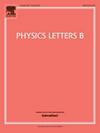Dynamical dark energy in the no-scale Brans–Dicke gravity
IF 4.5
2区 物理与天体物理
Q1 ASTRONOMY & ASTROPHYSICS
引用次数: 0
Abstract
We add a new scalar field in the no-scale Brans-Dicke gravity and require it to have a global O(2) symmetry with the original scalar field in the Brans-Dicke gravity. This gives us a new massless scalar field in the Einstein frame due to the SO(2) symmetry. We then explicitly break the O(2) symmetry to a symmetry, and this scalar field gains a periodic potential. This scalar field can serve as the quintessence field to explain dark energy. If we further add the term and the non-minimal coupling to the Higgs field, we can realize inflation and reheating, and this leads to a super-Planckian decay constant of the quintessence potential. The super-Planckian decay constant is consistent with the newly released observational data according to a recent analysis.
无标度Brans-Dicke引力中的动态暗能量
我们在无标度Brans-Dicke引力中增加了一个新的标量场,并要求它与原Brans-Dicke引力中的标量场具有全局的O(2)对称性。这给了我们一个新的无质量标量场在爱因斯坦坐标系中由于SO(2)对称性。然后我们显式地将O(2)对称打破为D4对称,并且这个标量场获得一个周期势。这个标量场可以作为解释暗能量的精粹场。如果我们进一步在希格斯场中加入R2项和非极小耦合,我们可以实现膨胀和再加热,这将导致精质势的超普朗克衰变常数。根据最近的一项分析,超级普朗克衰变常数与新发布的观测数据一致。
本文章由计算机程序翻译,如有差异,请以英文原文为准。
求助全文
约1分钟内获得全文
求助全文
来源期刊

Physics Letters B
物理-物理:综合
CiteScore
9.10
自引率
6.80%
发文量
647
审稿时长
3 months
期刊介绍:
Physics Letters B ensures the rapid publication of important new results in particle physics, nuclear physics and cosmology. Specialized editors are responsible for contributions in experimental nuclear physics, theoretical nuclear physics, experimental high-energy physics, theoretical high-energy physics, and astrophysics.
 求助内容:
求助内容: 应助结果提醒方式:
应助结果提醒方式:


